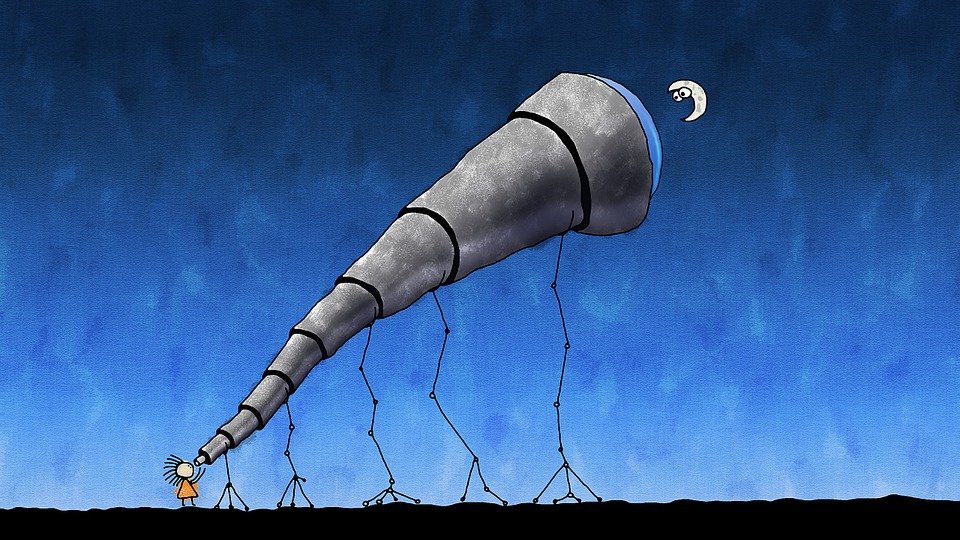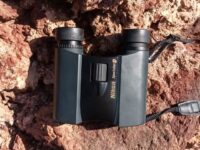 |
 |
The difference between telescope vs binoculars is how they are built and in their intended use. The word Binoculars means two eyepieces, they are of compact design, portable, and can be quickly used for viewing. Telescopes are Monoculars: they have one eyepiece, are bulky need a tripod and mounting and are intended for the observation of astronomical objects.
Binoculars or telescope?
Binoculars are in general used for terrestrial observation. In principle, they are two small telescopes that are mounted parallel to each other and which point in the same direction (collimated). To not project an upside-down picture, they have an additional internal extra lens (erecting lens) or more common in modern binoculars, prisms are used to correct the image. A telescope used for celestial observation does not necessarily need to show an upright image.
Today the term telescope is not just used in the classical sense anymore. Any kind of device used in Astronomy is called a telescope, whether it collects visible light, radio waves, game rays, or x-rays. Even the latest Gravitational wave detector (GOTO) is simply described as a telescope.
There is a very large selection of binoculars and telescopes one can choose from. Small compact pocket binoculars that fit in any pocket, to highly complex space telescopes that orbit the earth. What model and design are best to choose, depends entirely on where and for what purpose they are to be used.
Binoculars
Binoculars are usually relatively small and lightweight compared to telescopes and can be easily transported. Thanks to their compact dimensions binoculars can be kept in bags, pockets or around your neck. They will quickly be at hand when needed for observing animals in the wild or viewing any distant object of interest.
Binoculars are used for nature observation or surveillance but they are also used for astronomical purposes. Binoculars are used by astronomers for scanning the sky quickly to find a particular object. They are also very useful or for observing very large objects in their entirety such as the milky way.
As both eyes are used for viewing, binoculars project a 3D image and provide a better in-depth perception and a broader field of vision. However, the binoculars’ much smaller aperture compared to the aperture of a telescope limits their use in poor light conditions and has them work best during the daytime when there is plenty of ambient light.
Most handheld binoculars are very easy to use, simply point them at an object, adjust the focus and enjoy viewing. To use a telescope reading the manual and familiarization with their respective features is necessary.
Advantages of binoculars:
- quickly scan large portions of the night sky
- wide field of view
- portable, easy to handle
- affordable
- best suited for terrestrial viewing
- maintenance-free
Disadvantages of binoculars:
- no detailed viewing of celestial objects
- less suitable in low light conditions
Telescopes
Telescopes are the heart of astronomy. Hobby Astronomers, as well as scientists, use them to observe and learn about planets, stars, and other objects in the universe. Their high magnification allows detailed observation of, for example, craters and mare of the moon, planets of the solar system, or other distant celestial objects.
Even Telescopes for hobby astronomers are often large and bulky and are not easy to carry around. Most telescopes need a fixed stationary set up. Many hobby astronomers go as far as building a little observatory in their backyard or on the roof of their houses.
One of the most important features of a telescope is the aperture, not the magnification as beginners always misunderstand. The larger the aperture, the more light can be collected and dimmer objects may be observed. Binoculars are limited in this respect. The large telescope aperture is also the key feature for a high resolution and thus a high-contrast and detailed observation.
Telescopes for amateur astronomers come in many sizes and prices, you can get a small beginner telescope for a couple of hundred dollars. For the beginning hobby astronomers, a 3 to 4-inch Refractor or a 4 to 5-inch Reflector are a good size to start with.
But anyone who begins to like the hobby of observing the night sky will not stick to such small instruments and will soon be looking for larger and more powerful telescopes.
Advantages of telescopes:
- detailed viewing of celestial objects
- parallactic mount and computer-assisted tracking
- cameras can be attached
- suitable low light conditions
Telescope disadvantage
- requires occasional maintenance and adjusting
- not really suitable for nature or terrestrial viewing
- limited portability requires tripod and mount
- bulky
Binoculars versus telescopes
A good pair of binoculars with its large field of view helps to scan the sky and to quickly find an object of interest. It is the right tool to hunt for Komets or to admire the beauty of the milky way.
A telescope allows seeing details on the moon or our neighboring planets in the solar system. Also, distant galaxies and other dim and distant objects in the night sky that require magnification and light-gathering power can be observed.
There is no real debate whether a telescope or binoculars are better. Too different are their purpose and their applications. Every Astronomer utilizes both as they complement each other.
What is more important than just viewing objects through binoculars or telescopes, is to know what you are actually looking at. The fascination of celestial objects comes through comprehending what they really are.

